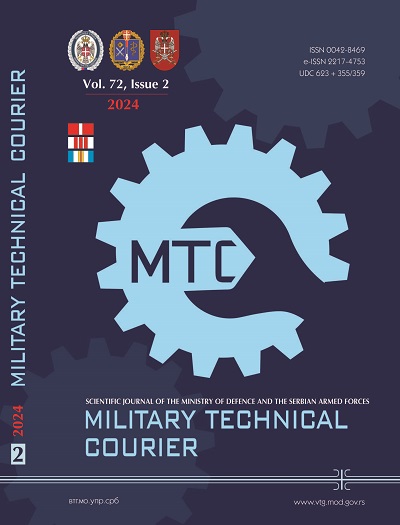Comparative analysis of the specific motor skills of cadets by classes after the second year of education
Abstract
Introduction/purpose: Despite the era of digitization, the assessment of the combat readiness of modern army members has always been associated with good physical fitness. When it comes to the specific physical abilities of the Military Academy cadets, their previous tests indicate that the values are within the expected limits. The aim of this work is to compare the values of the results in the specific motor skills of cadets by classes (groups) after the second year of schooling. It is hypothesized that there are differences in the results of the cadets by groups.
Methods: The sample consisted of a total of 932 male cadets within nine groups, after the second year of study, starting from the 2012/2013 school year. Four variables related to specific motor skills were included: pull-ups on a bar for 2 minutes, crunches for 2 minutes, 3200 m running, and overcoming infantry obstacles. Using statistical programs, the results of these four variables were processed through central and dispersion parameters. The univariate analysis of variance (ANOVA) was used to determine the differences between the groups in the achieved results. The multivariate analysis of variance (MANOVA) determined the differences in the system of variables with spaces.
Results: The analysis of the results of the specific motor abilities by groups after the second year of study determined that there are statistically significant differences in the variables “pull-ups on a bar” and “crunches”, while there are no statistically significant differences in the variables “3200 m running” and “overcoming infantry obstacles”.
Conclusions: The values of the results of the cadets in these four specific motor abilities are obviously within the limits provided by the Instructions and standards for evaluating cadets by age, so it was determined that there are no greater deviations than expected.
References
Aandstad, A., Sandberg, F., Hageberg, R. & Kolle, E. 2020. Change in Anthro- pometrics and Physical Fitness in Norwegian Cadets During 3 Years of Military Academy Education. Military Medicine, 185(7-8), pp. e1112–e1119. Available at: https://doi.org/10.1093/milmed/usz470.
Jamro, D., Zurek, G., Lachowicz, M. & Lenart, D. 2021. Influence of Physical Fitness and Attention Level on Academic Achievements of Female and Male Mil- itary Academy Cadets in Poland. Healthcare, 9(10, art.number:1261). Available at: https://doi.org/10.3390/healthcare9101261.
Marić, L., Krsmanović, B., Mraović, T., Gogić, A., Sente, J. & Smajić, M. 2013. The effectiveness of physical education of the Military Academy cadets during a 4-year study. Vojnosanitetski pregled, 70(1), pp. 16–20. Available at: https://doi.org/10.2298/VSP1301016M.
Marić, L.D., Marinković, M.D. & Ćorić, M.M. 2015. Assessment of the effective- ness of physical education classes based on weight index during cadets’ education at the Military Academy. Vojno delo, 67(4), pp. 186–194. Available at: https://doi.org/10.5937/vojdelo1504186M.
Marić, L. 2011. The development of the motor capabilities and its relations to the motor efficiency of the students at the Military Academy. Ph.d. thesis, Novi Sad, Serbia: University of Novi Sad.
Melnykov, A., Iedynak, G., Galamandjuk, L., Blavt, O., Duditska, S., Korya- gin, V., Balatska, L. & Mazur, V. 2018. Factors that influence changes in cadets’ physical preparation during the first half of study at a military academy. Journal of Physical Education and Sport, 18(2), pp. 781–786. Available at: https://doi.org/10.7752/jpes.2018.02115.
Vaara, J. 2017. Physical fitness trends in soldiers – Implications for recruitment and combat readiness. Journal of Science and Medicine in Sport, 20(2), p. S11. Available at: https://doi.org/10.1016/j.jsams.2017.09.029.
Copyright (c) 2024 Lela D. Marić, Mile P. Ranđelović

This work is licensed under a Creative Commons Attribution 4.0 International License.
Proposed Creative Commons Copyright Notices
Proposed Policy for Military Technical Courier (Journals That Offer Open Access)
Authors who publish with this journal agree to the following terms:
Authors retain copyright and grant the journal right of first publication with the work simultaneously licensed under a Creative Commons Attribution License that allows others to share the work with an acknowledgement of the work's authorship and initial publication in this journal.
- Authors are able to enter into separate, additional contractual arrangements for the non-exclusive distribution of the journal's published version of the work (e.g., post it to an institutional repository or publish it in a book), with an acknowledgement of its initial publication in this journal.
- Authors are permitted and encouraged to post their work online (e.g., in institutional repositories or on their website) prior to and during the submission process, as it can lead to productive exchanges, as well as earlier and greater citation of published work (See The Effect of Open Access).

